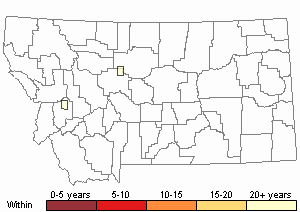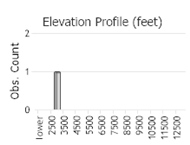View in other NatureServe Network Field Guides
NatureServe
Montana
Utah
Wyoming
Idaho
Wisconsin
British Columbia
South Carolina
Yukon
California
New York
Flat Pocket Moss - Fissidens fontanus
Other Names:
A Pocket Moss
General Description
Plants: Stems flaccid, long (120 x 6 mm), and highly branched. Yellow-green to dark green, sometimes becoming brown to black, especially in older sections.
Leaves: Leaves paired, lanceolate to linear-lanceolate and commonly slightly falcate, and up to 7.0 x 0.6 mm. Leaves usually 10 or more times as long as wide. Apex acute. Vaginant lamina about 1/3 to 1/2 the length of leaf. Dorsal lamina often ends before the base of leaf.
Leaf Cells: Laminal cells of 1-layer and smooth, but sometimes are 2-layered near costa. Median cells above the vaginant leaf are quadrate to hexagonal, thick-walled and slightly bulging, and become larger towards the costa. Margin entire with no border. Basal cells rectangular. Costa ends 15-35 cells before the apex.
Diagnostic Characteristics
When dry the leaves are fragile. Plants are often encrusted with diatoms. Could be confused with F. grandifrons which occurs in flowing water, but has pluristratose laminal cells. Because of their vaginant leaf, Fissidens are often confused for liverworts, particularly Diplophyllum.
Range Comments
Canada: BC, ON; United States: AL, AZ, AR, CA, CT, FL, GA, ID, IL, IN, IA, KS, KY, LA, ME, MA MI, MN, MS, MO, MT, NJ, NM, NY, NC, OH, OK. OR, PA, RI, SC, TN, TX, VA, WA, WV, WI; Mexico; West Indies; Central America; Europe; Africa (FNA 2007). In Montana, known from Cascade and Granite Counties (Elliott 2016).
Observations in Montana Natural Heritage Program Database
Number of Observations: 2
(Click on the following maps and charts to see full sized version)
Map Help and Descriptions
Relative Density

Recency



 (Observations spanning multiple months or years are excluded from time charts)
(Observations spanning multiple months or years are excluded from time charts)
Habitat
Aquatic, attached to rocks, soil, and other substrates in flowing and stagnant waters and in coastal estuaries.
Reproductive Characteristics
Seta 0.5-0.6 mm tall. Capsules are lateral, straight, erect, ovoid to cylindric, somewhat contracted under the mouth when dry, and 0.5-0.6 mm long. Calyptra smooth. Autoicous.
Perigonia and perichaetia on short (sometimes long) axillary branches, are 1-5 per leaf axil, and are inconspicuous.
Stewardship Responsibility
References
- Literature Cited AboveLegend:
 View Online Publication
View Online Publication Elliott, J.C. and A.K. Pipp. 2018. A Checklist of Montana Mosses (1880-2018). Updated 3 January, 2020. Montana Natural Heritage Program, Helena, Montana. 73 pp.
Elliott, J.C. and A.K. Pipp. 2018. A Checklist of Montana Mosses (1880-2018). Updated 3 January, 2020. Montana Natural Heritage Program, Helena, Montana. 73 pp. Flora of North America Editorial Committee, eds. 2007. Flora of North America North of Mexico. Volume 27. Bryophytes: Mosses, Part 1. Oxford University Press, Inc., NY. xxi + 713 pp.
Flora of North America Editorial Committee, eds. 2007. Flora of North America North of Mexico. Volume 27. Bryophytes: Mosses, Part 1. Oxford University Press, Inc., NY. xxi + 713 pp.
- Additional ReferencesLegend:
 View Online Publication
View Online Publication
Do you know of a citation we're missing? Elliot, J. C. 1993. Second checklist of Montana mosses. Unpublished report. U.S. Forest Service, Region 1. Missoula, MT. 45 pp.
Elliot, J. C. 1993. Second checklist of Montana mosses. Unpublished report. U.S. Forest Service, Region 1. Missoula, MT. 45 pp. Lawton, E. 1971. Keys for the Identification of the Mosses on the Pacific Northwest. Reprinted from 'Moss Flora of the Pacific Northwest'. Published as Supplement No. 2 of the Journal of the Hattori Botanical Laboratory. Nichinan, Miyazaki, Japan. 66 pp.
Lawton, E. 1971. Keys for the Identification of the Mosses on the Pacific Northwest. Reprinted from 'Moss Flora of the Pacific Northwest'. Published as Supplement No. 2 of the Journal of the Hattori Botanical Laboratory. Nichinan, Miyazaki, Japan. 66 pp. Lawton, E. 1971. Moss Flora of the Pacific Northwest. Hattori Botanical Laboratory. Japan: Yamabuki-cho, Shinjuku-ku, Tokyo. 362 pages plus appendices.
Lawton, E. 1971. Moss Flora of the Pacific Northwest. Hattori Botanical Laboratory. Japan: Yamabuki-cho, Shinjuku-ku, Tokyo. 362 pages plus appendices.
- Web Search Engines for Articles on "Flat Pocket Moss"





